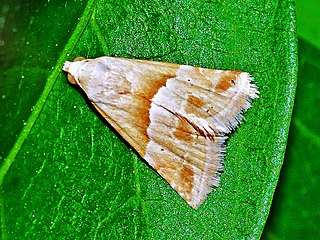
Gracillariidae is an important family of insects in the order Lepidoptera and the principal family of leaf miners that includes several economic, horticultural or recently invasive pest species such as the horse-chestnut leaf miner, Cameraria ohridella.

Pterolonchidae is a small family of very small moths in the superfamily Gelechioidea. There are species native to every continent except Australia and Antarctica.

The Spilosomina are a subtribe of tiger moths in the tribe Arctiini, which is part of the family Erebidae.
Cimeliidae, the gold moths, is a family of moths that is now placed in the macroheteroceran superfamily Drepanoidea, although previously placed in its own superfamily. Uniquely, they have a pair of pocket-like organs on the seventh abdominal spiracle of the adult moth which are only possibly sound receptive organs. They are quite large and brightly coloured moths that occur in southern Europe and feed on species of Euphorbia. Sometimes they are attracted to light. The family was first described by Pierre Chrétien in 1916.

Eois is a genus of moths in the family Geometridae. The genus contains about 250 validly described species, most from the Neotropical region. Many species are still undescribed and the total number of species is estimated to be over a 1,000 in the Neotropical region alone. The genus was first described by Jacob Hübner in 1818.
Reisserita is a genus of moths belonging to the family Tineidae.

Cyligramma magus is a moth of the family Noctuidae first described by Félix Édouard Guérin-Méneville in 1844. It is found in most of Sub-Saharan Africa.

Argyresthiidae is a family of moths known as the shiny head-standing moths. It was previously treated as a subfamily of Yponomeutidae.

Eublemma parva, the small marbled, is a moth of the family Erebidae. The species was first described by Jacob Hübner in 1808.
Urodeta is a genus of moths of the family Elachistidae. The genus was originally assigned to the family Momphidae.
Pseudoradiarctia is a genus of moths in the family Erebidae from Afrotropics.

Achaea lienardi, or Lienard's achaea, is a fruit piercing moth of the family Erebidae first described by Jean Baptiste Boisduval in 1833. It is found in most countries in tropical Africa from Egypt to South Africa, including the islands of Madagascar, Réunion and Mauritius. The larva may feed on various plants, belonging to the genera Maerua, Pappea, Rhus, Citrus, Schotia, Sideroxylon, Ptaeroxylon, Acacia, Allophylus, Croton, Pinus and Ricinus.

Achaea finita, the finite achaea, is a moth in the family Erebidae. It is found in the Democratic Republic of the Congo, Eritrea, Ethiopia, Ghana, Kenya, Réunion, Madagascar, Mozambique, Nigeria, Rwanda, Sierra Leone, South Africa, Uganda, Zambia and Zimbabwe.
Pseudoradiarctia affinis is a moth in the family Erebidae. It was described by Max Bartel in 1903. It is found in Ghana, Sierra Leone and Tanzania.
Pseudoradiarctia lentifasciata is a moth in the family Erebidae. It was described by George Hampson in 1916. It is found in South Africa, Zambia and Zimbabwe.
Pseudoradiarctia pallida is a moth in the family Erebidae. It was described by Patrick G. Haynes in 2011. It is found in Kenya, Malawi, Tanzania and Zimbabwe.
Pseudoradiarctia rhodesiana is a moth in the family Erebidae. It was described by George Hampson in 1900. It is found in Angola, the Democratic Republic of the Congo, Kenya, Malawi, Rwanda, South Africa, Tanzania, Uganda and Zimbabwe.
Pseudoradiarctia scita is a moth in the family Erebidae. It was described by Francis Walker in 1865. It is found in Cameroon, the Democratic Republic of the Congo, Ghana, Nigeria, South Africa, Tanzania, the Gambia, Uganda and Zambia.
Pseudoradiarctia tanzanica is a moth in the family Erebidae. It was described by Patrick G. Haynes in 2011. It is found in Tanzania.
Trichaeta parva is a moth in the subfamily Arctiinae. It was described by Per Olof Christopher Aurivillius in 1910 and is found in Guinea-Bissau.







